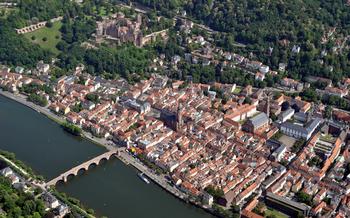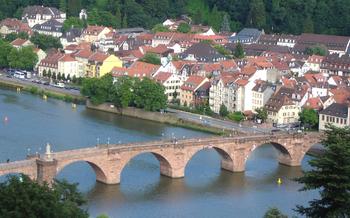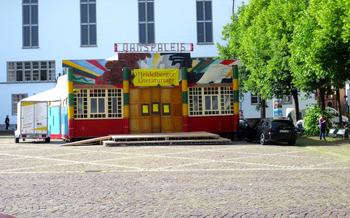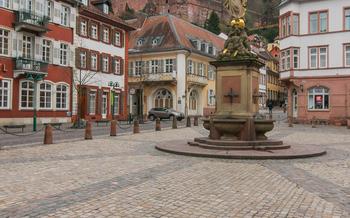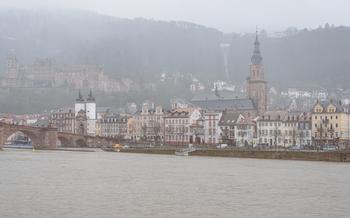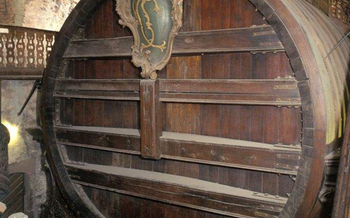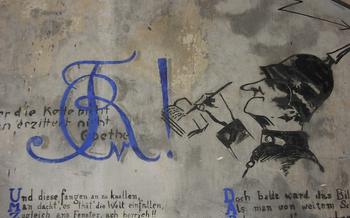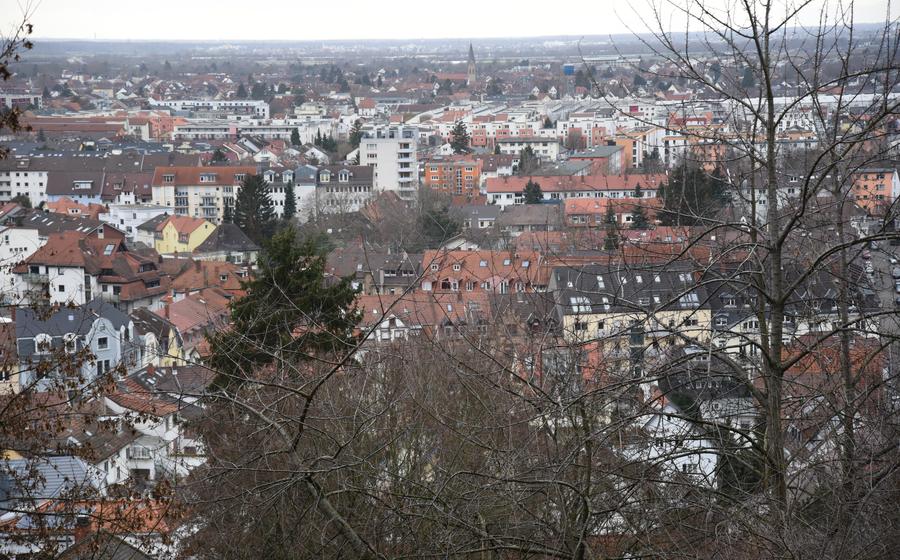
St. Peter’s Church
- Historical Significance
- Architectural Marvel
- Interior Beauty
- Heidelberg University Connection
- Historical Figures
- Concerts and Events
- Guided Tours
- Accessibility
- Opening Hours and Admission
- Photography and Videography
- Dress Code
- Nearby Attractions
- Local Cuisine
- Insider Tip
Historical Significance
St. Peter's Church has played a pivotal role in Heidelberg's history, serving as a spiritual and intellectual beacon for centuries. Its roots can be traced back to the 12th century, when it was a small Romanesque chapel. Over the years, it underwent several expansions and modifications, reflecting the changing religious and cultural landscape of the city.
During the Protestant Reformation, St. Peter's Church became a center of religious debate and reform. In 1518, Martin Luther, the renowned theologian and reformer, delivered a powerful sermon within its walls, challenging the authority of the Catholic Church and sparking the Protestant movement in Germany. This historic event transformed St. Peter's Church into a symbol of religious freedom and a gathering place for Reformist thinkers.
Throughout the centuries, St. Peter's Church has witnessed significant architectural evolution. In the 15th century, it was enlarged and remodeled in the Gothic style, featuring intricate carvings and soaring spires. Later, during the Renaissance period, the church underwent further modifications, incorporating Renaissance elements such as elegant arches and decorative motifs. These architectural transformations reflect the changing artistic and cultural influences that shaped Heidelberg over time.
Architectural Marvel
St. Peter's Church stands as a testament to the harmonious blend of Gothic and Renaissance architectural styles. Its facade, adorned with intricate details and sculptures, captivates the eyes with its intricate carvings and delicate tracery. The towering spires and buttresses that soar towards the sky lend an air of grandeur and majesty to the structure.
The church's exterior boasts a rich tapestry of Gothic elements, such as the pointed arches and ribbed vaults that define its architectural style. These elements create a sense of verticality and lightness, drawing the gaze upward towards the heavens. The Renaissance influence, on the other hand, is evident in the classical motifs and ornamentation that adorn the facade. Pilasters, cornices, and pediments add a touch of elegance and sophistication to the overall design.
The fusion of these two distinct styles has resulted in a unique and captivating architectural masterpiece. St. Peter's Church stands as a testament to the skill and artistry of its builders, who seamlessly blended the Gothic and Renaissance traditions to create a structure that is both awe-inspiring and harmonious.
Interior Beauty
Step inside St. Peter's Church, and prepare to be mesmerized by its breathtaking interior. The walls are adorned with stunning stained glass windows, depicting biblical scenes with vibrant colors and intricate details. The ceiling is a masterpiece in itself, covered in elaborate frescoes and paintings that narrate stories from the Bible and the history of the church.
Look closely at the interior carvings and sculptures, which showcase the exceptional craftsmanship of the medieval artisans. From the intricately carved choir stalls to the ornate pulpit, every corner of the church is a testament to the artistic and spiritual devotion of its builders.
The highlight of the interior is undoubtedly the magnificent high altar, a masterpiece of Renaissance art. Created by Hans Seyfer in 1510, the altar features a stunning triptych depicting scenes from the life of Jesus Christ. The intricate carvings, delicate paintings, and use of gold leaf make this altar a true work of art.
Heidelberg University Connection
St. Peter's Church shares a profound and enduring connection with Heidelberg University, one of the oldest and most prestigious universities in Germany. Throughout its rich history, the church has served as a spiritual and academic hub for the university community.
In its early days, the church provided a sacred space for university students and professors to congregate for religious services and theological discussions. The university's close association with the church fostered an environment conducive to intellectual growth and spiritual exploration.
Over the centuries, St. Peter's Church has hosted numerous university events and ceremonies, including matriculation ceremonies, doctoral promotions, and academic conferences. These events have imbued the church with a sense of academic solemnity and tradition.
The church's proximity to the university campus has further solidified its role as a gathering place for students and scholars. Throughout the academic year, the church's pews are often filled with students seeking solace, inspiration, or a place to quietly pursue their studies.
Today, St. Peter's Church remains an integral part of Heidelberg University's identity. It serves as a poignant reminder of the university's deep-rooted history and its enduring commitment to academic excellence.
Historical Figures
Throughout its rich history, St. Peter's Church has been associated with several notable figures who have left an indelible mark on the church and the city of Heidelberg. One of the most prominent figures is Martin Luther, the renowned leader of the Protestant Reformation. In 1518, Luther delivered a sermon within the church's walls, passionately advocating for his reformist ideas and igniting a movement that would change the course of religious history.
Other notable figures associated with the church include prominent scholars and theologians. Among them is Zacharias Ursinus, a leading theologian of the Reformed tradition, who served as a professor at Heidelberg University and is buried within the church. His contributions to Protestant theology and education have left a lasting legacy in the academic and religious landscape of the city.
The church also holds the graves of other notable figures, such as Samuel Werenfels, a prominent Swiss theologian and philosopher, and Friedrich Spanheim the Elder, a renowned theologian and orientalist. These individuals, along with many others, have contributed to the intellectual and spiritual heritage of Heidelberg and are commemorated within the sacred space of St. Peter's Church.
Concerts and Events
In addition to its religious significance, St. Peter's Church is also a vibrant cultural hub, hosting a variety of concerts and events throughout the year. The church's exceptional acoustics and stunning ambiance make it an ideal venue for musical performances, ranging from classical concerts to contemporary recitals. Visitors can enjoy the talents of renowned musicians and ensembles, immersing themselves in the harmonious melodies that reverberate within the sacred space.
Beyond musical performances, the church also hosts special events and exhibitions that showcase local culture and history. These events provide a unique opportunity to learn more about Heidelberg's rich heritage and traditions. From art exhibitions featuring works by local artists to historical reenactments depicting significant moments in the city's past, there is always something new and exciting to discover at St. Peter's Church. Whether you are a music enthusiast, a history buff, or simply seeking a unique and enriching experience, the church's diverse offerings cater to a wide range of interests and provide a memorable addition to any visit to Heidelberg.
Guided Tours
For a more in-depth exploration of St. Peter's Church, guided tours are available. Led by knowledgeable guides, these tours provide visitors with insights into the church's rich history, architectural wonders, and religious significance. During the tour, visitors will learn about the church's role in the Protestant Reformation, the intricate details of its Gothic and Renaissance architecture, and the stories behind the stunning stained glass windows and elaborate ceiling frescoes.
The guided tours also offer an opportunity to visit areas of the church that are not accessible to the general public, such as the sacristy and the crypt. These exclusive spaces provide a glimpse into the behind-the-scenes workings of the church and offer a unique perspective on its history. Visitors will also have the chance to ask questions and engage in discussions with the knowledgeable guides, making the tour an interactive and educational experience.
Tours are available in various languages, ensuring that visitors from all over the world can learn about the church's history and significance. To book a guided tour, visitors can contact the church office in advance or inquire at the information desk upon arrival. Whether you're a history buff, an architecture enthusiast, or simply someone who appreciates beautiful spaces, a guided tour of St. Peter's Church is an enriching experience that will leave you with a deeper understanding and appreciation for this iconic landmark.
Accessibility
In the heart of Heidelberg's picturesque Old Town, nestled amidst charming cobblestone streets and historical landmarks, lies St. Peter's Church. Its central location makes it easily accessible for visitors exploring the city's rich heritage. The church stands in close proximity to other notable attractions, such as the Heidelberg Castle, the Old Bridge, and the University of Heidelberg.
Reaching St. Peter's Church is a breeze with Heidelberg's efficient public transportation system. Multiple tram and bus lines stop nearby, making it convenient to hop on and off and explore the city's many treasures. For those who prefer the comfort of their own vehicle, parking garages and street parking options are available within walking distance.
Whether you're a history buff, an architecture enthusiast, or simply seeking a moment of tranquility amidst the vibrant city, St. Peter's Church is a must-visit destination. Its accessibility and proximity to other attractions make it an ideal starting point for a comprehensive Heidelberg itinerary, promising a memorable and enriching experience.
Opening Hours and Admission
Currently, St. Peter's Church welcomes visitors from Monday to Saturday, between 10:00 AM and 5:00 PM. It remains closed on Sundays, allowing for religious services and private contemplation. Admission to the church is free of charge, allowing all visitors to explore its beauty and history without any financial barriers. It extends a warm invitation to individuals, groups, and families to immerse themselves in its sacred atmosphere and marvel at its architectural wonders, without any financial burden.
Photography and Videography
St. Peter's Church welcomes visitors to capture the beauty and grandeur of its interior and exterior through photography and videography. However, it is important to maintain respect for the sanctity of the church and the privacy of religious services.
When taking photographs or videos, please be mindful of the following guidelines: - Silent Mode: Ensure that your camera or phone is set to silent mode to avoid disturbing ongoing services or events. - Flash Photography: Flash photography is generally not permitted within the church to preserve the integrity of the artworks and stained glass windows. - Respect for Services: During religious services, it is crucial to be respectful and refrain from taking photographs or videos. Wait for an appropriate moment, such as before or after the service, to capture your shots. - Commercial Use: If you intend to use your photographs or videos for commercial purposes, please seek permission from the church authorities beforehand.
Dress Code
When visiting St. Peter's Church, it is important to dress respectfully, as it is an active place of worship. Visitors should avoid wearing shorts, tank tops, or other revealing clothing. It is also customary to remove your hat or head covering upon entering the church.
While there is no strict dress code enforced, it is recommended to dress modestly and conservatively. This shows respect for the religious significance of the church and the people who worship there.
If you are unsure about what to wear, it is always best to err on the side of caution and dress more formally. This will ensure that you are comfortable and respectful during your visit.
Nearby Attractions
In the vicinity of St. Peter's Church, a plethora of captivating attractions awaits the curious traveler. The Old Town, with its cobbled streets and half-timbered houses, invites you to wander and explore its hidden nooks and crannies. Stand in awe of the grandeur of Heidelberg Castle, perched majestically atop Königstuhl hill, offering panoramic vistas of the city and the Neckar River. Discover the fascinating stories of renowned scholars and thinkers at the University of Heidelberg, Germany's oldest university. Take advantage of the opportunity to visit the Heidelberg Tun, the world's largest wine barrel, capable of holding an astounding 220,000 liters of wine. For nature enthusiasts, a delightful stroll along the banks of the Neckar River offers a tranquil escape from the urban hustle and bustle.
Weave these attractions into your Heidelberg itinerary to create a tapestry of experiences that will leave you with lasting memories. Start your day by delving into the rich history of St. Peter's Church, then immerse yourself in the charm of the Old Town. Ascend to Heidelberg Castle for a regal perspective of the city, followed by a thought-provoking visit to the University of Heidelberg. Raise a toast to your adventures at the Heidelberg Tun before unwinding with a leisurely walk along the Neckar River. This carefully curated itinerary ensures a comprehensive exploration of Heidelberg's cultural and historical treasures.
Local Cuisine
In the heart of Heidelberg's Old Town, an array of culinary delights awaits visitors near St. Peter's Church. From traditional German cuisine to international flavors, the area offers a diverse gastronomic experience.
For a taste of local specialties, head to Gasthaus zum Seppl, just a stone's throw from the church. This charming restaurant serves up hearty dishes like schnitzel, bratwurst, and maultaschen, accompanied by refreshing German beers.
For a more contemporary dining experience, try the nearby Restaurant zur Goldenen Gans. This stylish establishment offers a modern take on German cuisine, with dishes that showcase local ingredients and innovative culinary techniques.
If you're looking for a quick bite, there are several cafes and bakeries in the vicinity. Cafe Extrablatt, located right across from the church, is a popular spot for coffee, pastries, and light meals.
And for those with a sweet tooth, Chocolaterie Amelie is a must-visit. This artisan chocolate shop offers a tempting selection of handmade chocolates, truffles, and other confections, perfect for a sweet treat or a souvenir to take home.
Insider Tip
As you wander through the church, keep an eye out for the hidden gem known as the "Devil's Stone." Legend has it that this stone, located near the entrance, was once used by the devil as a stepping stone to climb to the top of the church tower. Look closely, and you'll notice a slight indentation on the stone, said to be left by the devil's fiery hooves.
For a truly unique photographic opportunity, visit the church during the "Blue Hour," just after sunset. As the sky transforms into a deep indigo hue, the church's silhouette against the twilight creates a breathtaking spectacle. Capture this magical moment with your camera to cherish a memory that will last a lifetime.

